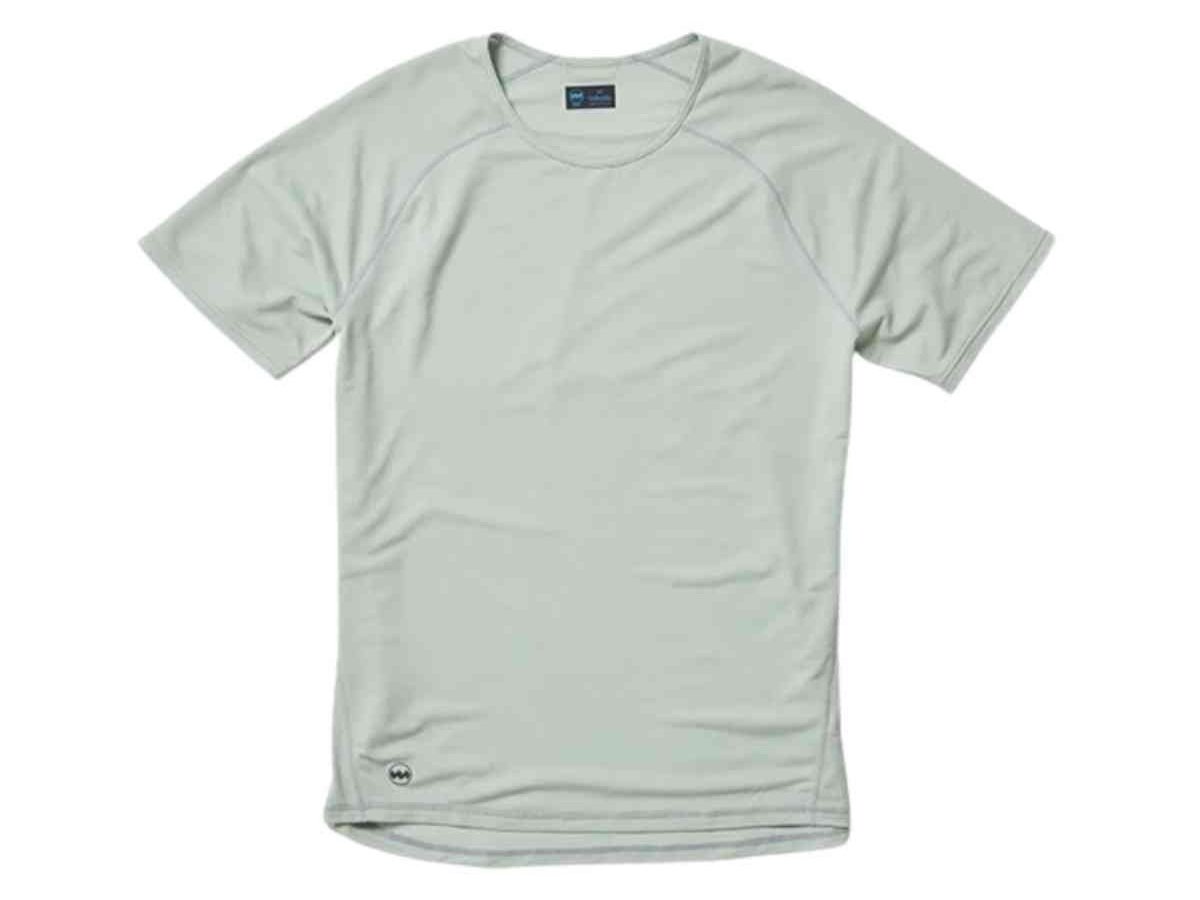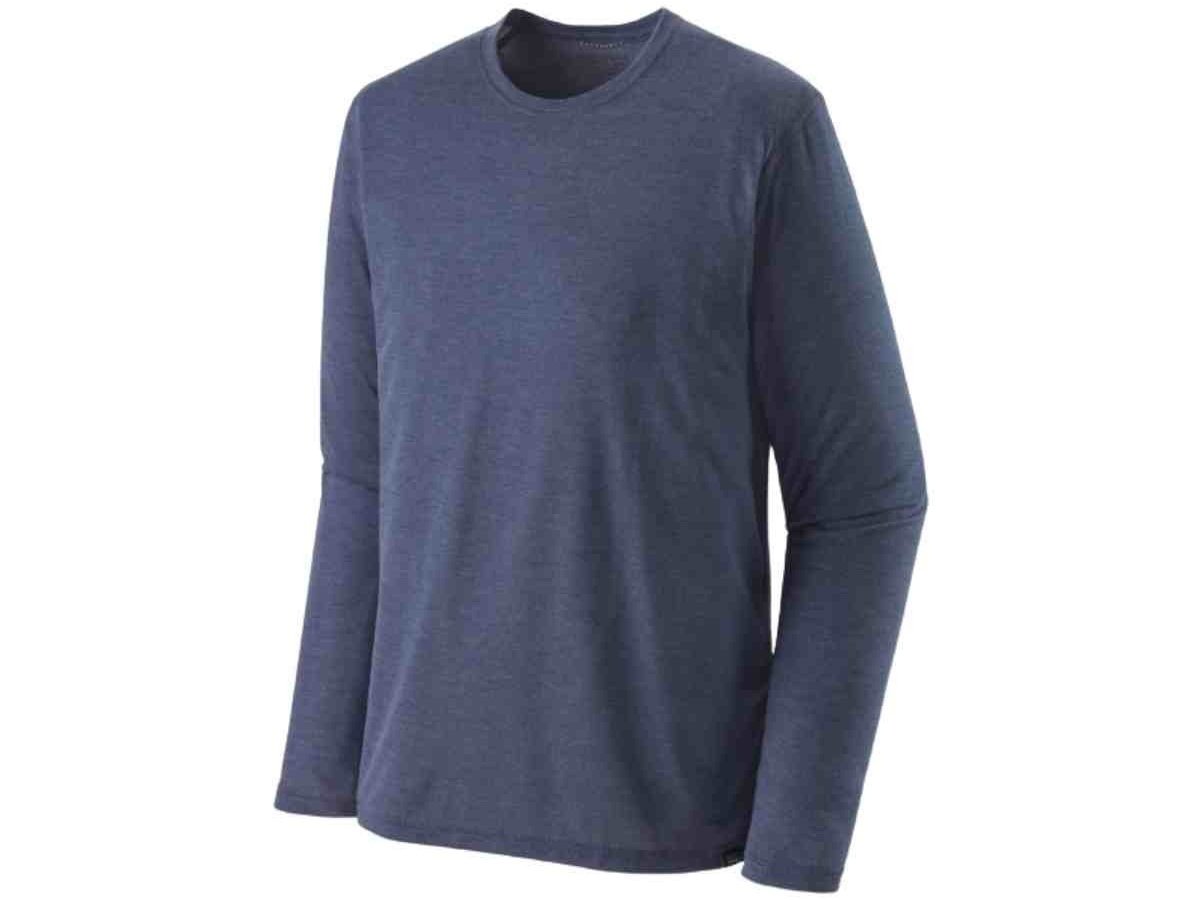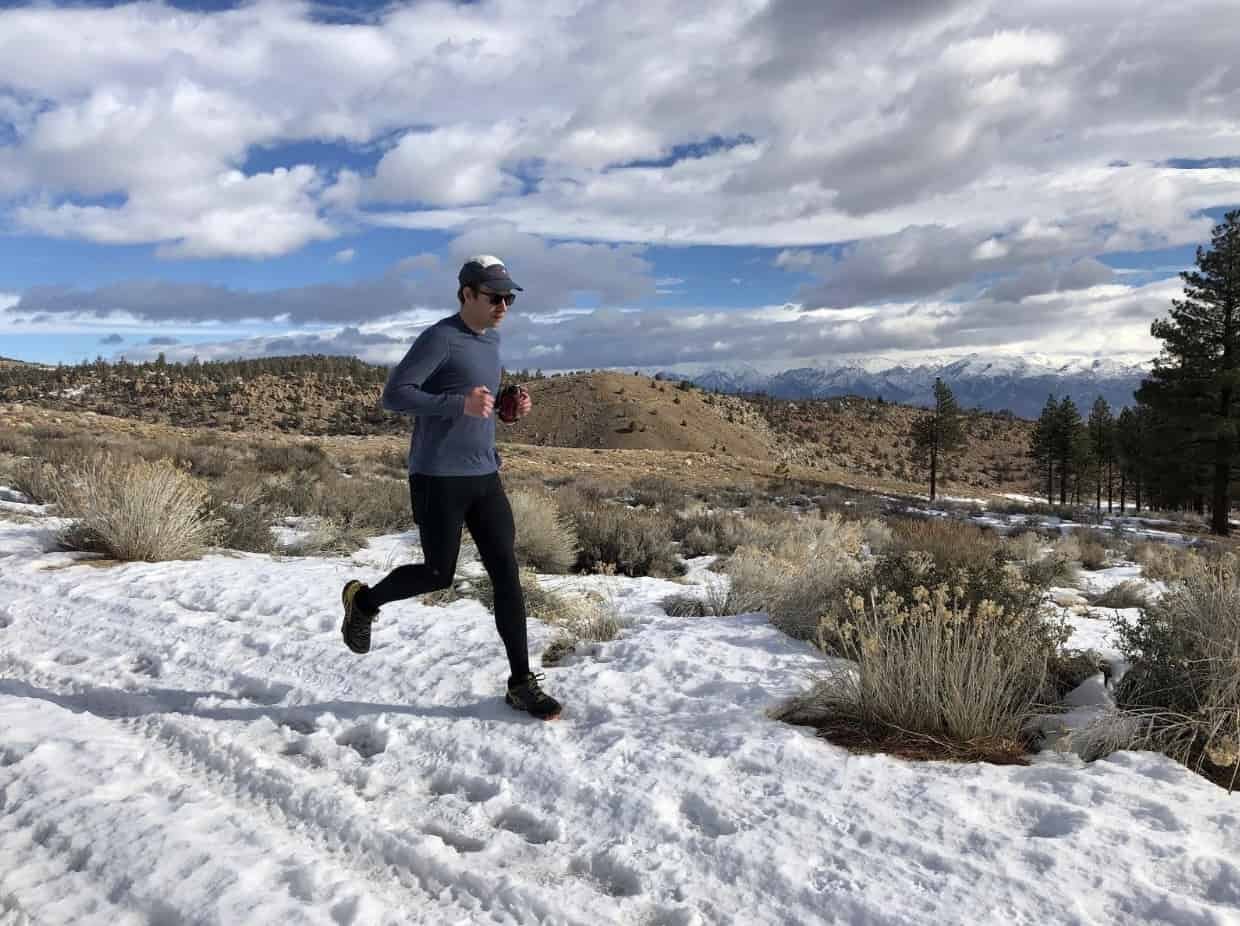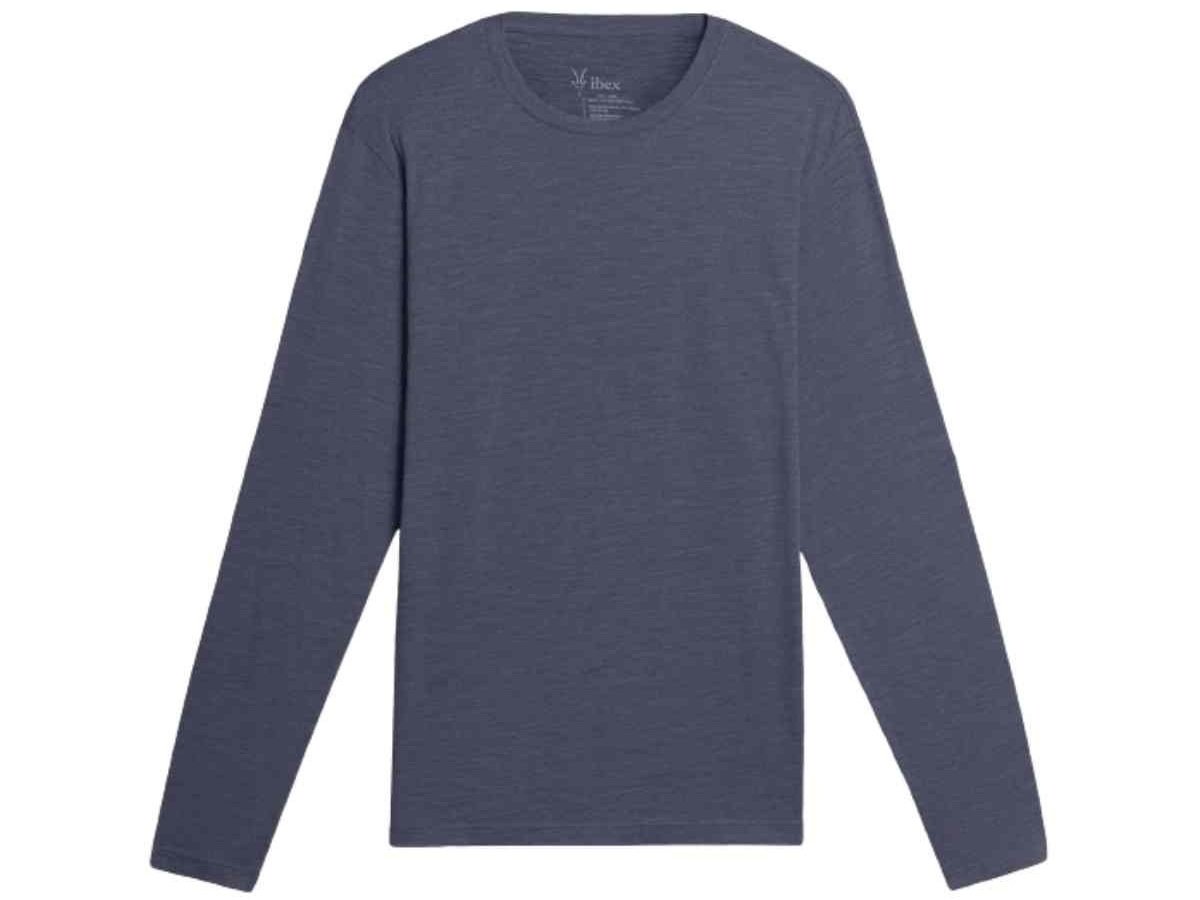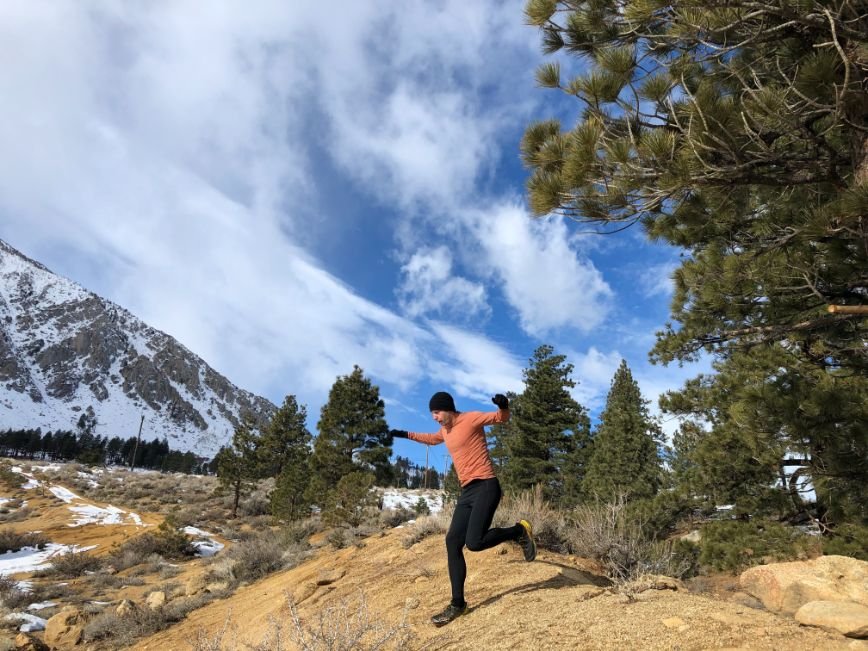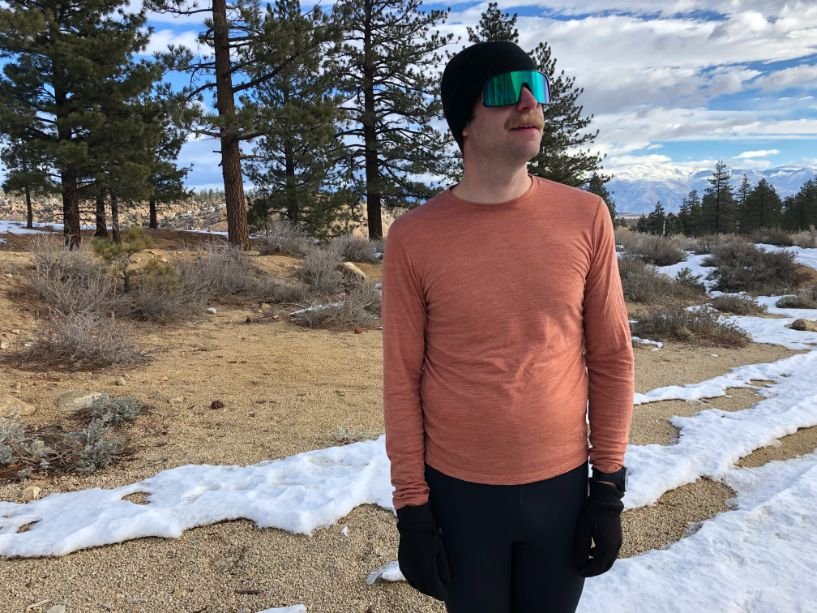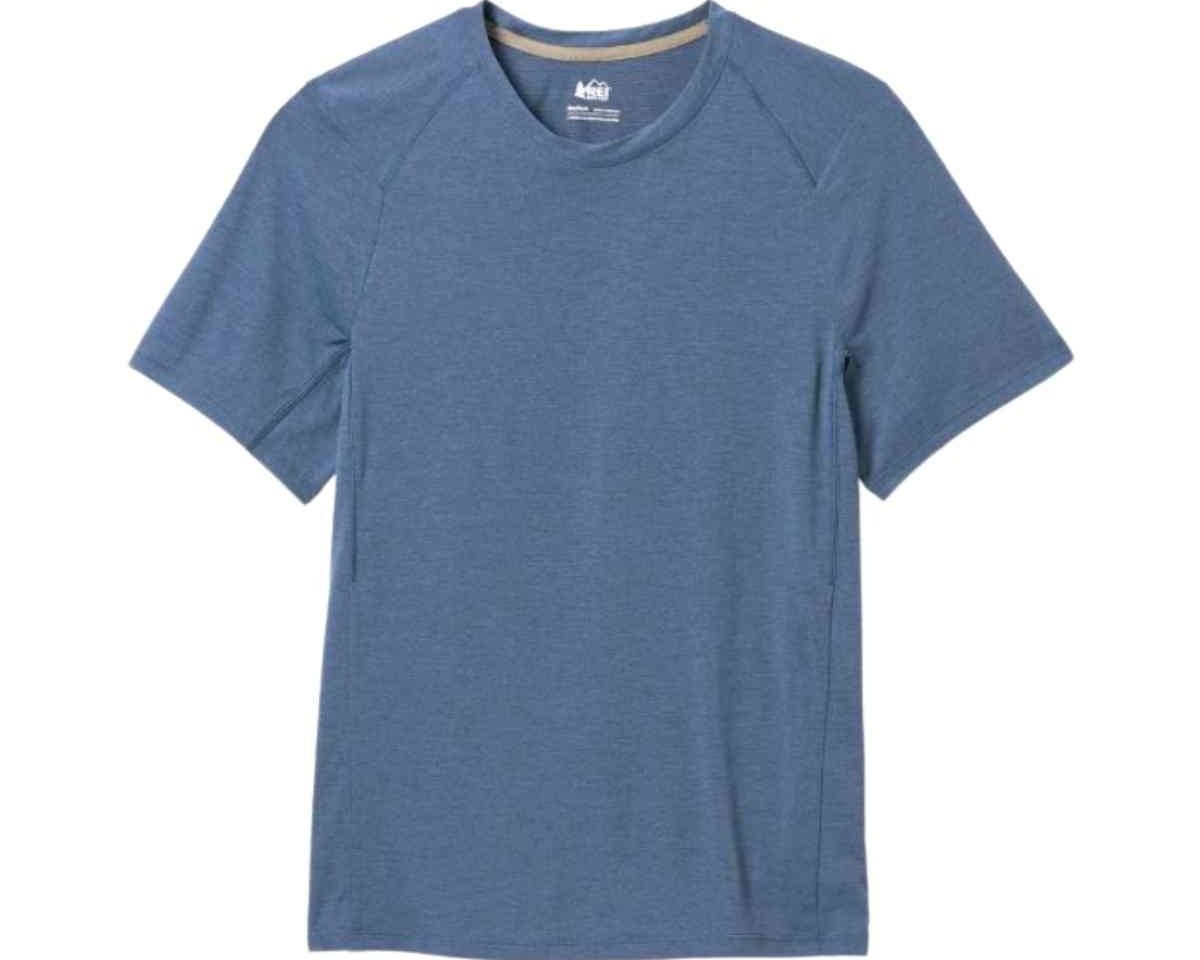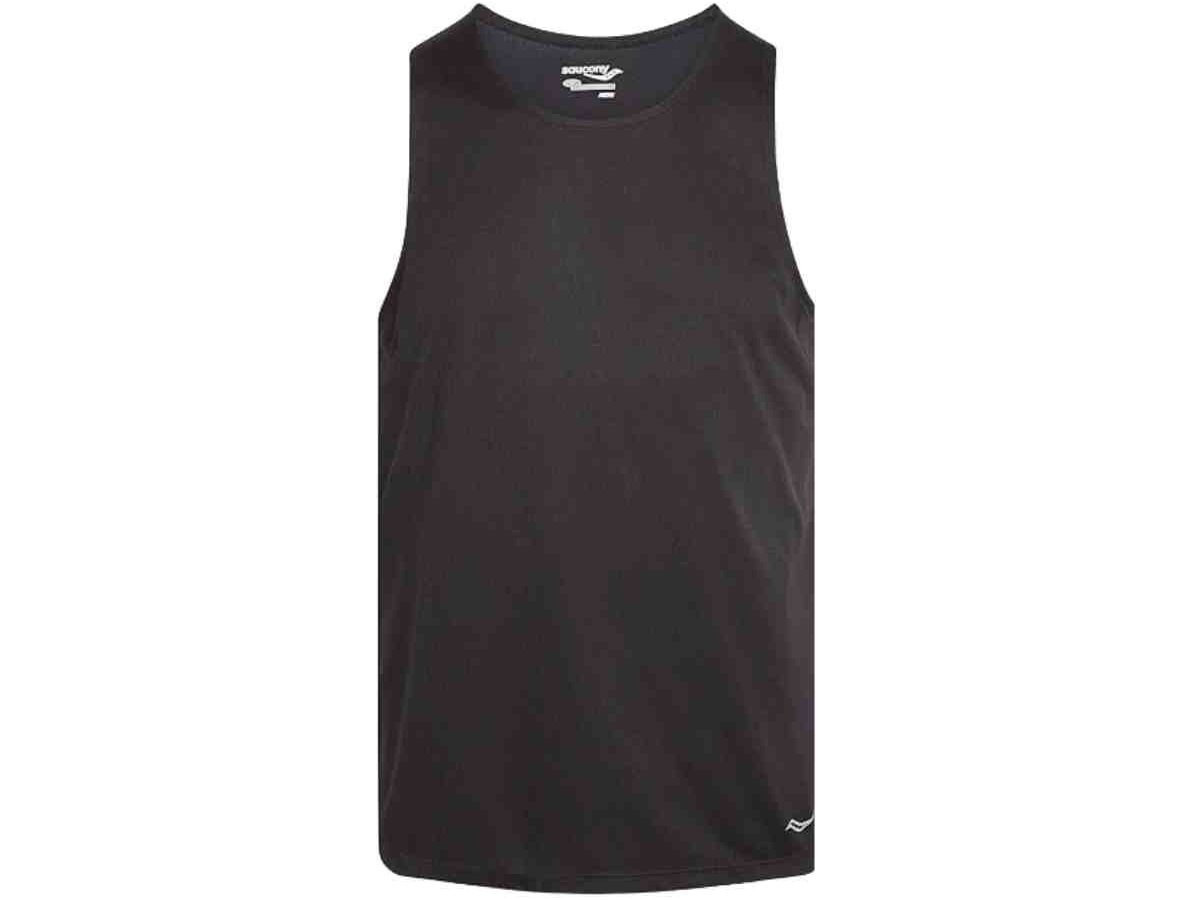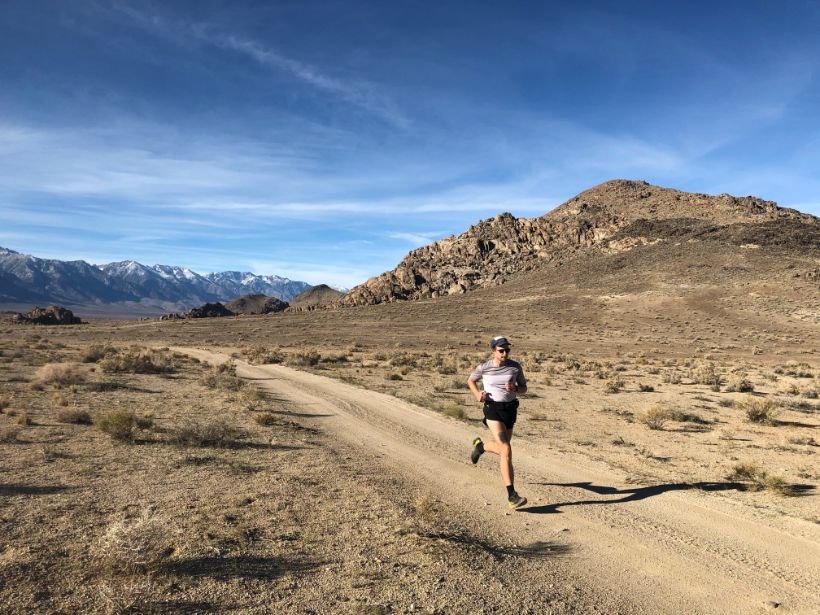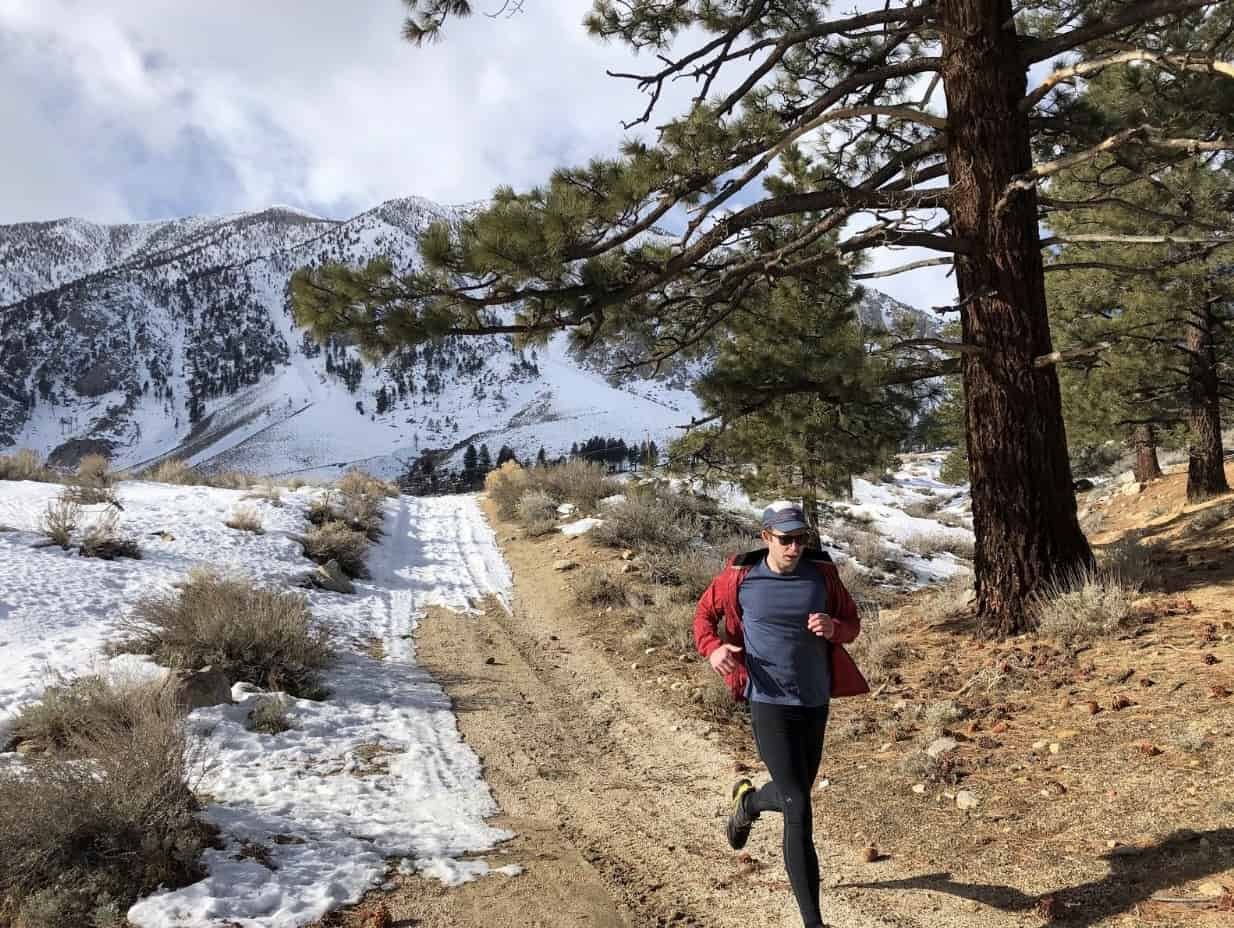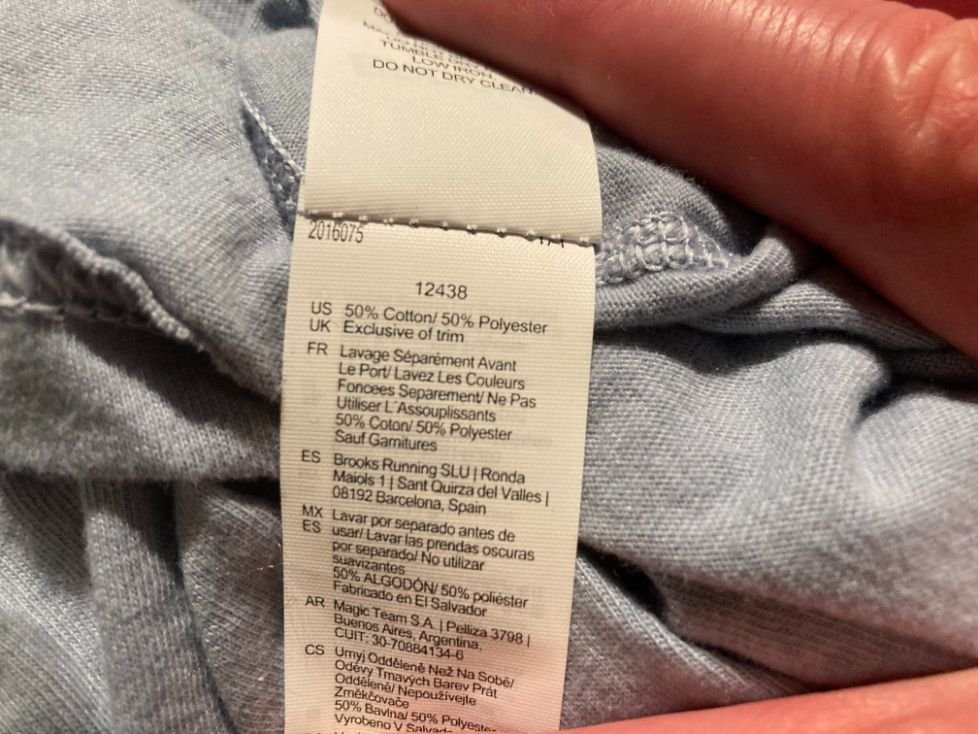Best Running Shirts for Men of 2024
men’s running shirts: t-shirts, long sleeve, sleeveless for hot and cold weather runs
April 30th, 2024
Home > Gear Reviews > Apparel
We reviewed 16 men's running shirts and tested them on desert trails, the Pacific coast, high alpine mountains, and suburban roads to find the best running shirts for men. Over hundreds of miles of running, we tested these running shirts to find the best shirts for runners in all seasons.
Running is an aerobic and anaerobic sport, meaning your heart rate will vary significantly, from a feeling of easy effort to one you can only sustain for short bursts. Your body will go through different levels of producing heat and evaporative self-cooling (aka, sweating).
The running shirt is the primary layer you’ll wear over your core, your greatest heat source and regulator. It covers friction points under your arms while swinging, on your back when running with a pack, or around your waist when wearing a running belt. It’s a regulator and a buffer; it’s also a matter of personal style. Your running shirt comes on every run, and a running shirt might be one of the first things you buy when getting into running.
There are a few fabric choices for running shirts, but also many nuances in terms of fit, breathability, temperature management, odor control, and range of motion. We’ve tested running models that take varying approaches to the humble running shirt and found that the Janji Helio Tech Quick Dry is the best running shirt for men.
For women's running shirts, see our Best Women's Running Shirts guide.
We create reader-supported, objective gear reviews independently selected by our editors. This story may contain affiliate links, which help fund our website. When you click on the links to purchase gear, we may get a commission, without costing you an extra cent. Thank you for supporting our work and mission of outdoor coverage for every body! Learn more.
Men's running shirts comparison table
| MEN'S RUNNING SHIRT | TREELINE AWARD | SIZES | FIT | WEIGHT | SLEEVE LENGTHS AVAILABLE | FABRIC |
|---|---|---|---|---|---|---|
| Janji Helio Tech T | Best Overall Read why |
S - XL | Standard to slim | 3.0 oz (L) | S/S, L/S | 100% Polyester with HeiQ® Fresh Treatment |
| Patagonia Capilene Cool Trail | Best Long Sleeve Read why |
XS - XXL | Standard | 6.5 oz (M) | S/S, L/S | 100% polyester (50% recycled) spun jersey with HeiQ® Pure odor control |
| Ibex Paradox Long Sleeve | Best Merino Read why |
S - XXL | Slim | 5.8 oz (M) | S/S, L/S | 45% Merino Wool, 45% Tencel, 10% Nylon |
| REI Swiftland Running T-Shirt | Best Affordable Read why |
S - XXL + Tall sizes | Standard | 3.3 oz (M) | S/S, L/S | 100% Polyester Blue Sign Approved® |
| rabbit Welcome to the Gun Show Tank | Best Sleeveless Read why |
S - XL | Standard to slim | 6.4 oz (M) | Singlet | 95% Polyester, 5% Spandex |
* We note any discounts we see on our Deals page, which is updated daily.
Interested in running? Check out the Running Gear section:
The winners
Best overall men's running shirt: Janji Helio Tech Tee
Available sizes: S - XL
Fit: Standard to slim
Weight: 3 oz (L)
Fabric: 100% Polyester with HeiQ® Fresh Treatment
What we liked: It does everything advertised well and more
What we didn’t like: Not the most inclusive sizing, runs small
The Janji Helio Tech running t-shirt was our clear winner for the best overall running shirt; it breathes, doesn’t feel clammy, has an airy, almost absent feel against the skin, and dries quickly. It precedes our testing with glaring reviews to give us extra confidence in our findings while testing the shirt.
100% polyester. That’s nothing special. We’d wager to say that most running shirts are either 100% or mostly polyester. What is unique about the Janji Helio Tech is how Janji has knit it, styled the shirt, and how it feels and performs across various conditions, not just hot ones.
JANJI HELIO TECH TEE
The author running in the Janji Helio Tech in the Tungsten Hills above the Owen’s Valley, CA. Photo by Trey French
Versatility
The Janji Helio Tech is well suited for wearing all day casually, then going out for an hour-long run layered under a wind jacket on a below 35° evening in the high desert of the Owen’s Valley in California. It’s equally suited to pushing hard up a 1,200-foot-per-mile climb in the 60s, then wandering, somewhat lost, on that run for 2 hours past sunset. We took it shuffling through the arid Alabama Hills and running in coastal California, in dry and more humid conditions. It’s versatile.
Odor-free
Many polyester running shirts struggle with odor once the sweating starts, and our body's natural bacteria start mixing with the fabric. Janji combats this by using a textile treatment from HeiQ® called Fresh Treatment. It’s supposed to last the life of the garment. After our testing, which included 1 full day of casual wear ending with a run, then running in it two more days before washing it, we’re pleased with the funk (or lack thereof). We wouldn’t wear it to meet the parents, but it’s acceptable at a minimum.
The 3-dimensional knit fabric inside of the Janji Helio Tech T. Photo by Sasha Hashemipour
Fabric, seams, and reflective detailing
For the fabric, Janji uses a 3-dimensional knit, which absorbs and transfers moisture away from your body for quick drying and keeping the shirt from feeling clingy when sweating. The Helio Tech shirt also has the common but crucial flatlock seams to prevent chafing (see more on that below). It also has a couple of small reflective watermarks that shine when they need to but are subtle during the day.
Hang loops
A nice final touch is that Janji puts a minimal hang loop on the outside of the back of the neck of the shirt. Our reviewer has never been great with using hang loops, as they’re hidden inside the shirt and take some effort during the laundry chore. But hang loops are important because hang drying is one more way to extend the life of a lightweight shirt like the Helio Tech. Don’t worry; per the care tag, you can tumble dry low, too.
High desert runs are only one of the many places and conditions where the Janji Helio Tech excels. Photo by Sasha Hashemipour
Durability
We haven’t had any durability issues or found anyone – customer or magazine – reporting abnormal wear. Just in case, Janji backs their gear with a 5-year warranty against manufacturer defects. Janji also donates 2% of all purchases to clean water projects and displays their partners and status with them on their site.
Sizing
We don’t have any complaints about the actual Helio Tech shirt, but we want to mention some things. Firstly, Janji doesn’t have the most inclusive sizing offerings. We’d love to see Janji rectify this, as the largest size currently for this shirt is an XL.
Fit
The second minor issue is that the shirts run a little small for what we’re used to getting for the size. The sizing chart also reflects this, so our reviewer sized up from his normal size, and it’s a perfect (for him) flowy but not baggy shirt. We recommend sizing up.
What others are saying
Reviewers backed up our positive experiences with the Janji Helio Tech. Reviewers consistently find the Helio Tech to have exceptional breathability and wicking properties and say that the 3-D mesh is a joy to wear. They also talk about how well the shirt performs in seriously hot and humid conditions, which we couldn’t test in the high arid deserts of the eastern Sierra or the cooler season on the Pacific coast.
Our verdict
Despite the sizing drawbacks, this is the running shirt we’d wear next to skin for everything but extreme cold conditions. It moves with you, disappears after a few minutes of movement, and is the one we’ll recommend to our buddies.
Interested in running? Check out the Running Gear section:
BEST LONG-SLEEVE RUNNING SHIRT FOR MEN: PATAGONIA CAPILENE COOL TRAIL LONG SLEEVE
Available sizes: XS - XXL
Weight: 6.5 oz (M)
Fit: Standard
Fabric: 100% polyester (50% recycled) spun jersey with HeiQ® Pure odor control
What we liked: Casual look and feel with a performance for running
What we didn’t like: Won’t be the best for extreme heat or extreme cold, but works in most conditions
The Patagonia Capilene Cool Trail shirt is our winner for best long sleeve running shirt. We want a versatile long-sleeved running shirt that can be worn as a base layer in cold weather and offer some sun protection from UV rays with breathability and wicking in warmer weather. It's a winner in our Best Sun Shirts guide for that reason. The Capilene Cool Trail L/S keeps the stink at bay, it’s durable, and it’s versatile. If you run exclusively in long sleeve shirts, we think it's worth purchasing multiples of the Patagonia Capilene Cool Trail shirt and making these your daily drivers.
The Capilene Cool Tech sits right in the middle of a runner's temperature needs. It won’t be the warmest choice for a winter base layer, but it has a home in chillier conditions with proper layering. It won’t be the coolest shirt out there for extreme weather, but it will perform for most of the warmer conditions that most people run in.
The Capilene Cool Trail may be marginally thicker than some of the other Capilene styles out there (there are many!), fits more “regular,” and is less technical looking than some other Capilene options. For example, for the Best Women's Running Shirts guide, the slightly lighter weight Capilene Cool Daily running t-shirt was a winner for best eco-friendly running shirt.
PATAGONIA CAPILENE COOL TRAIL LONG SLEEVE
Running in the Capilene Cool with the bigger White Mountains in the background waiting for spring adventures. Photo by Sasha Hashemipour
Fabric
Patagonia states that the Capilene Cool Trail is their “softest performance knit.” It’s made with a knit that feels like cotton but performs all the wicking and breathing duties we ask of it.
The next-to-skin feel offers immediate comfort when putting the shirt on. The underarm gussets and a stretch in the fabric assist with articulation, which can be an asset, especially so in slim-fitting garments, for keeping the arm swing unrestricted while running. The 100% polyester (50% recycled) keeps the shirt light and technical.
Anti-odor
Similar to our best overall pick, the Janji Helio Tech T, Patagonia uses the anti-stink coating from the HeiQ® application. Patagonia uses HeIQ's Pure application, which is a “silver-salt-based” additive that is more environmentally friendly.
We wore the Capilene Cool Trail for three runs in a row averaging about an hour each in 35°F (with a wind shell) to 55°F temps before washing it. It was on par with the Janji smell test, with just a little funk under the arms. It’s no merino wool, like the Ibex Tencel, which had almost no odor (see more below). But we have no problem getting multiple uses out of the Cool Trail.
Sustainability and Ethical Labor
It’s widely known that Patagonia creates products with a list of sustainable environmental practices and through ethical labor relationships. The Capilene Cool Trail is no exception. It’s made within the bluesign® system to reduce the environmental impact of working with textiles, with 50% of the shirt made from recycled polyester. The Cool Trail is also made through a relationship with a fair trade factory to support fair labor conditions, including living wages.
Some days a short sleeve isn’t enough. Others, a shell is too much. A standard weight long sleeve like the Patagonia Capilene Cool Trail may be perfect. Photo by Sasha Hashemipour
Quality
The Capilene Cool Trail is also on a growing list of our favorites from Patagonia. Their Strider Pro shorts in our Men's Running Shorts guide and the Patagonia Houdini in our Men's Windbreakers guide are other examples. What we’ve come to find with Patagonia is that the quality is consistently impressive.
Fabric thickness
We don’t have much criticism for the Capilene Cool Trail, but we want to shed some light on some minor customer complaints. One is that the Cool Trail is a little thicker than some of the other Capilene shirts.
On the other hand, some runners find it too thin for casual use regarding how revealing it is. Put plainly: some reviewers find that it’s too see-through. We didn’t notice this, but maybe it’s a matter of getting it in the right light. We haven’t found the shirt overly thin, but it has a finish a little thinner than some of our daily cotton shirts.
Who else likes it
An Outside reviewer found it to be the best in his quiver of shirts that offer cotton's comfort and style while having synthetics' performance benefits.
Durability
Both customer and professional reviewers mention a superficial amount of fabric pilling on the fabric. Still, none have suggested that it was unusually severe or caused premature wear in the shirt. We couldn't find complaints about holes or tears from snags through trail use, either (and didn't have any issues in our own testing).
Other versions
While we tested the Cool Capilene Trail and think it excels as a long sleeve running shirt, it's also available as a running t-shirt. The long sleeve version is a staple to include in your Cold Weather Running Gear List, but if you love the material and want to extend its use into warmer seasons, consider the short sleeve for summer.
Our verdict
The Cool Capilene Trail long sleeve shirt wicks sweat, dries respectably fast, holds off the stink, looks casual, and ranks among the most comfortable shirts we’ve tested. It’s our best long sleeve running shirt. It won’t be the warmest choice for a winter base layer, but it has a home in chillier conditions with proper layering. It won’t be the coolest shirt out there for extreme weather, but it will perform for most of the warmer conditions that most people run in.
BEST MERINO WOOL RUNNING SHIRT FOR MEN: IBEX PARADOX LONG SLEEVE
Available sizes: S - XXL
Fit: Slim
Weight: 5.8 oz (M)
Fabric: 45% Merino Wool, 45% Tencel, 10% Nylon
What we liked: Merino, Tencel, nylon blend makes for exceptional temp regulating, cooling, and shirt durability. Extremely comfortable it’s a versatile shirt for use beyond running (casual, skiing)
What we didn’t like: The price comes off as high, but it’s priced standard among its peers, and isn't bad considering it can be used for more than running
The Ibex Paradox Long Sleeve is our winner for Best Merino Wool Running Shirt. It helps address challenges common in merino as a running fabric such as being too warm or being slower to dry. During our testing in the eastern Sierra and southern California, we found that the Ibex Paradox running shirt performs beyond all other merino run shirts we’ve tried.
Our reviewer doesn’t usually go for merino wool for hot temperatures, as they can run a little warmer than other options in extreme heat. Ibex recognizes merino wool’s shortcomings when used in a running shirt—like how it often droops more than synthetic shirts, is slower to dry, runs warmer in the sun, and can be less durable on thinner knits. The Ibex Paradox addresses these issues by mixing merino with Tencel, making it an excellent choice for a merino running shirt.
IBEX PARADOX LONG SLEEVE
Bounding over and down small hills is just plain fun in the Ibex Merino Tencel Photo by Sasha Hashemipour
Testing notes
We tested the long sleeve as a sole layer for running in cool temperatures. We used it as a base layer, layered with fleece and windshells during the fall and winter seasons. The merino wool, Tencel (a soft fiber often made from eucalyptus), and nylon blend on the Ibex Paradox Long Sleeve has us second-guessing our beliefs that merino can’t be a top-performing running shirt fabric when the temperatures rise.
Fabric
The merino in the shirt shines in a few ways. One, it’s thin enough to fall into the lightweight shirt category at 150g/m, or 19 microns. Ibex states that the thinnest of merino wool falls into the range of 16-19 microns, as opposed to a medium or “midweight” cold weather shirt.
Though it isn’t the fastest drying fabric compared to ultra-thin polyester, it dries quicker than other heavier merino knits. Not only does it keep the shirt breathable and drying faster, but it also retains merino’s claim to fame—its supreme temperature-regulating properties.
Versatility and anti-odor
These features lend the Ibex Paradox Long Sleeve shirt a level of versatility to the point that we felt comfortable doing some ski touring wearing it. It kept us cool on the uphill and warm on the downhill after doing the customary layering up.
We just kept on wearing it for the rest of the day, which brings us to the anti-stink benefits of merino. It’s arguably the most effective at keeping the smells down, and this shirt does it well.
Comfort
Though merino is less scratchy than traditional wool, this shirt has next-to-skin softness thanks to the addition of Tencel fiber. It also avoids any itch factor you might occasionally find wearing merino shirts. Tencel, like cotton, is a natural fabric, but unlike cotton, it has regulating and wicking properties similar to synthetics and merino wool.
One place you may have heard about Tencel is the world of bedsheets. There it’s known for its smooth feel, cooling properties on hot nights, and for hot sleepers. The nylon in the “core,” as Ibex notes, helps with the fabric's durability, with nylon having a slight edge over polyester regarding the durability of synthetics. Tencel also reduces droop in fabrics, giving the shirt a sleeker look.
The Ibex Merino Tencel is slim fitting, but we found the fabric one of the most comfortable of all of the shirts we tested. Photo by Sasha Hashemipour
Value
We don’t have any complaints about the Ibex Paradox Long Sleeve, but you should consider some factors when dealing with merino. It will almost always be more expensive than synthetic fabrics. Also, as a long sleeve, it will be more expensive than t-shirts and singlets we consider.
Temperature regulation
Though we were impressed with the warmer weather performance of the shirt, we haven’t used it in scorching conditions of 90°+. That’s typically where we want an ultra-thin, lightweight synthetic for the best cooling effects possible, given our experiences with merino in the past.
Who else likes it
Gear Junkie gave the Ibex Tencel, the previous name of this shirt, the top wool pick, and Outdoor Gear Lab assigned it the title of the best base layer. We’d agree on both accounts. Gear Lab’s emphasis on this as a prime base layer supports our experience as the fabric regulates temps well, which can help with cold weather running, and varying intensities while wearing multiple layers. For that reason, we think it's a solid addition to our Cold Weather Running Gear List.
Durability
We’ve had small holes develop on full merino shirts, but so far, so good on the Ibex Tencel; maybe the nylon is doing its job there.
Customer reviewers find the shirt durable, too—to the point that some customers take it climbing, which is tough on pretty much all gear with the abrasive nature of fabric against rock.
Fit
Customer reviews also find that the Merino Tencel fits on the slim side, and we would agree. Not compression level tight, but a little slimmer than Ibex describes it.
Our verdict
The Ibex Paradox Long Sleeve may be a little pricey and probably won’t be your hot-weather running shirt. Still, it will take care of most of your running needs in cooler weather as a moisture-and-temperature-managing, smell-resistant, durable, good-looking, and good-feeling running shirt. We give it two thumbs up.
Best affordable men's running shirt: REI Swiftland
Available sizes: S - XXL + Tall sizes
Fit: Standard
Weight: 3.3 oz (M)
Fabric: 100% Polyester Blue Sign Approved®
What we liked: Great value, on sale periodically, breathes well, Tall sizing
What we didn’t like: No frills build may not be for everyone
The REI Swiftland running t-shirt is our winner for Best Budget Men's Running Shirt. It got a lot going for it as a running shirt: 1) it retails at $40, 2) it’s an REI product that's available year-round, 3) it has all the basic wicking, breathability, comfort, and durability performance traits of a running shirt. As a customer reviewer succinctly put it, it’s a “great, no-nonsense shirt.” We’re confident in giving it our best affordable men’s running shirt title.
REI SWIFTLAND
One of the many dirt roads where tested the REI Swiftland running shirt. Photo by Sasha Hashemipour
Fabric
REI offers the Swiftland tech fabric in other running garments, but we think the fabric excels in the form of the Swiftland running shirt. The 100% “Swiftex” polyester fabric, REI’s self-proclaimed lightest technical fabric, wicks well, and the breathability is aided by a grid stretch fabric that, when held up to the light, shows smaller and larger perforations designed to let air pass through.
Temperature regulation
The shirt is a bit thin, with a pretty open weave, so it’s favorable to temperatures on the warmer side. However, it’s not so thin and airy that we wouldn’t recommend wearing it up mountain peaks in the shoulder season with a wind shell (we did just that).
Features
The REI Swiftland T doesn’t compromise on standard running shirt performance features. One example of this is that it has underarm gussets—a testament to REI’s aim to make this a well-articulating shirt. Underarm gussets aren’t a requirement for a performance running shirt, but can help with articulation when the shirt fabric isn’t the most stretchy or if it fits on the slim side.
Surprisingly, REI uses standard seams rather than flatlock seams on the inside. This proved to be a non-issue for us, but some users may require a flatlock for chafing prevention. Photo by Trey French
Stretch and durability
The REI Swiftland has a great balance of stretch and durability. In addition to running with it in the eastern Sierra, we also took it on a 4-hour desert bushwack in southern California, which involved some unavoidable snags. We thought that the thin nature of the shirt would mean an end to its integrity, but surprisingly, it came away with only a single loose thread. We clipped the loose thread with scissors and haven’t had any issues.
Anti-odor
There’s no anti-stink application on the Swiftland T, and despite being 100% polyester, it has an acceptable funkiness after prolonged running. This isn’t always the case. Polyester is infamous for broadcasting the smells that result from bacteria from our bodies mixing with this synthetic fiber. To help fight the funk, check out our guide on the Best Sports Detergent.
Sizing
Lastly, one of the things we like about this shirt, as is often the case with REI, is that the sizing is pretty inclusive. There is availability in the men’s version ranging from a size S-XXL + tall sizes, so more people can take advantage of the Swiftland value.
Sustainability
Fabrics used in the REI Swiftland are bluesign® certified with an environmental protection approach in mind. It’s also made through a Fair Trade certified™ factory, honoring workers by ensuring they receive a fair living wage. Both these factors make it similar to our best long sleeve running shirt, the Patagonia Capilene Cool Trail (review above).
What others say
Reviewers enjoy the Swiftland for running, hiking, gym or workout use, and general outdoor recreation. Some reviewers mentioned that it performed for them in both dry and humid conditions, not sagging or clinging in humid conditions. We’re thrilled to hear that, since our testing happened in primarily dry, mountain-west conditions. The reviews seem to be exclusively related to warm weather use, which makes sense given the thin, breathable build of the shirt.
Value
Our only knock on the price would be its lack of versatility for layering in cold conditions beyond shoulder season use. That’s more of an understandable limitation than a fault.
Seams
Lastly, one thing that stood out is that REI doesn’t use flatlock seams on this shirt when most of the shirts on our list did. That said, we nearly forgot that this was the case, as the soft fabric (not at all abrasive) never bothered our skin. We do want to point this out though, as some runners do struggle with chafing, and may need flatlock seams to be a standard feature on their running shirts.
Our verdict
Again, the Swiftland has all the basic wicking, breathability, comfort, and durability performance traits of a running shirt. It does not have the all-together absent airy feel or temperature-regulating performance of our overall winner, the Janji Helio Tech T, or the anti-stink or regulating properties of the Ibex Paradox. But for many people, these are more features than essentials needed to go for a run. Keep it simple and affordable with the Swiftland T.
BEST SLEEVELESS RUNNING SHIRT FOR MEN: RABBIT WELCOME TO THE GUN SHOW TANK
Available sizes: S - XL
Weight: 4.1 oz (M)
Fit: Standard to slim
Fabric: 95% Polyester, 5% Spandex
What we liked: Superb stretch, fun pattern, doesn’t cling, breathable
What we didn’t like: It’s surprisingly heavy for a singlet. Not for those looking for protection from UV rays
The rabbit Welcome to the Gun Show Tank, which we’ll refer to as a singlet, has us dreaming of hot weather just for an excuse to wear this shirt. Spending most of our time with it in coastal southern California in the mid to high 70s, we found it fun to wear, with breathable fabric following in line with its naturally breathable design as a singlet. That's what makes the rabbit Welcome to the Gun Show Tank our winner for best sleeveless running shirt.
Our reviewer often likes to go shirtless when weather conditions are appropriate for something like a singlet. Still, some instances call for modesty, and some marginal sun protection at minimum is good for everyone. Compared to other singlets we’ve tried, the rabbit Welcome to the Gun Show Tank offers the best stretch, breathability, comfort, and lack of cling, giving it the edge for the best sleeveless running shirt on our list.
The rabbit Tank is made of rabbit MESH, 95% polyester, and 5% elastane, with a perforated pattern across the shirt. The polyester does the wicking and breathing, and the elastane does the stretching.
RABBIT WELCOME TO THE GUN SHOW TANK
Running in the San Diego, CA sun in the rabbit Welcome to the Gun Show Tank after things had been cooling down in the Eastern Sierra mountains. Photo by Sasha Hashemipour
Fabric
We chalk up the heavier weight of the rabbit Tank compared to some others to the elastane, which is often a heavy fiber and adds weight to all garments it's in. We believe the extra weight is fair trade, though, since the shirt doesn’t cling or sag when sweating, at least not for us. We’d be interested in getting more feedback in the most challenging of sweaty conditions like the humid southeast or eastern woodlands of the US, where sun levels are high, and so is the moisture content in the air.
Fit and sizing
Customer reviews often highlight the semi-fitted style of the rabbit Tank, describing it as tailored, athletic, or even just “fitted,” referring to a slight taper in the midsection. This feature helps keep the shirt from bouncing around. One reviewer mentioned that they often tuck in singlets to keep them still, but didn’t feel that it was necessary on this one.
Reviewers also mentioned that the straps over the shoulders stay put, are no fuss, and don’t require any adjustment. A recurring review talks about how soft the fabric is, even cotton-like, and we agree. It’s a pleasant fabric! One reviewer mentioned that he had run a marathon in it without issue, and some use it as a daily warm-weather trainer.
As far as sizing goes, some reviews mention that it runs slim, so it might be worth sizing up if you prefer a looser fit.
The Welcome to the Gun Show singlet has perforated sections on all of the rabbits. It’s cute, and functional! Photo by Sasha Hashemipour
Style
When we pair the Welcome to the Gun Show with a 3” split style running short, the combo makes our reviewer feel pretty fast. Maybe this is because that’s what track runners wear, and maybe they’re onto something.
If singlets are your style, you aren’t looking for a lot of UV coverage, and you want to maximize breathability, the rabbit Welcome to the Gun Show has a lot going for it. This tank is the sleeveless shirt we’ll keep reaching for at the peak of summer with a thick layer of sunscreen.
Other men's running shirts we tested
The North Face Sunriser
Available sizes: XS - XXL
Fit: Standard
Weight: 3 oz (M)
Fabric: Front body and sleeves: 80D 79 g/m² 100% recycled polyester with FlashDry™. Back Upper Yoke: 80D 79 g/m² 100% polyester with FlashDry™
What we liked: Breathes well, dries quickly
What we didn’t like: A little stiff, quick to harbor smells
We love the detailed specs on The North Face Sunriser and its careful approach to design for a specific use case. It also breathes and wicks pretty well, especially the rear of the shirt, with an open and stretchy knit. It also is a pretty reasonable price for a running shirt. Unfortunately, we found the front to hold more static than other shirts and felt scratchy.
THE NORTH FACE SUNRISER
Running after the first small snow storm, and before the big one in the high Sierra, in TNF Sunriser. Photo by Sasha Hashemipour
The Sunriser also harbored the most intense smell of the shirts we tested, which can be a problem with some fully polyester garments. For a similar type of shirt that we favored, check out the Janji Helio Tech or the REI Swiftland.
Available sizes: S - XXL
Fit: Standard to slim
Weight: 3.1 oz (M)
Fabric: 100% Recycled Polyester
The Saucony Stopwatch is one of the most popular running singlets out there. In testing, it was just edged out by the rabbit Welcome to the Gun Show for Best Sleeveless Running Shirt. The Stopwatch has a slightly straighter and more loose cut than the more trim Rabbit shirt, which is neither good nor bad, but is up to a runner's preference.
SAUCONY STOPWATCH SINGLET
Sunny warm conditions are fitting for singlets, which provide maximum breathability. We recommend it if you don’t mind it’s more static material. Photo by Sasha Hashemipour
Some runners like a more trim fit to keep the bounce down, while others like the air circulation of a looser shirt. What we liked more about the rabbit shirt was that it had some stretch and articulation, while the Saucony Stopwatch was pretty static or non-stretch. The women's Saucony Stopwatch was a winner for Best Affordable Running shirt in our Best Women's Running Shirts guide. The Stopwatch will do the job, just not to the level of the Rabbit shirt.
Available sizes: XS - XXL
Fit: Standard
Weight: 4.75 oz (L)
Fabric: 50% Cotton, 50% Polyester
The Brooks Distance t-shirt is one of the most comfortable running shirts against the skin in our testing—likely because it’s 50% cotton. We don’t typically recommend cotton for outdoor applications and won’t start here, but that’s not to say that the Brooks Distance doesn’t have a place in running. It’s just limited. If comfort is what you’re after, consider the Ibex Merino Tencel.
Our reviewer only uses cotton blends for short runs from the house in hot weather. The cotton can feel nice at first before proceeding to have an unwanted chilling effect over a long period of time. It also gets heavy with a lot of sweat. While we like the Brooks Distance, we’ve been wearing it more as a comfortable casual shirt than a running shirt.
BROOKS DISTANCE T-SHIRT
We tested the SOAR Hot Weather T (now discontinued) in the infamously toasty Alabama Hills not far from the Badwater Ultramarathon route. Photo by Sasha Hashemipour
What to look for in a running shirt
Fabric
Like many technical garments, running shirts are typically made of synthetic fabrics like polyester and nylon (and all their branded names). Some runners prefer merino wool for its temperature regulation and odor management (more on that later). You’ll see traces of other fabrics like spandex, rayon, and cotton in running shirts. These are often added for durability or to give a better fit or more style.
The shirts in our review are mostly polyester, which is the norm for running shirts; they’re typically more affordable and easier to produce than nylon and merino wool. Polyester wicks effectively, dries quickly, and holds its shape. A typical downside of polyester is that it often stinks, though some manufacturers incorporate anti-odor applications that produce varying levels of success.
Fabric weight
Unlike insulated garments that report weight on a per meter or yard basis, running shirts typically advertise the overall weight of the garment using a men’s medium as a consistent baseline for comparison. This weight for t-shirts, non-singlet, or long-sleeve styles usually ranges (with exceptions) from around 2.5oz to 5oz, with 2.5oz shirts being the thinnest.
Thinner shirts are often polyester-based, with excellent airflow, but are not well-suited for cooler temperatures. Thicker shirts are suitable for non-peak summer conditions and tend to be made of merino wool; or, they may simply incorporate extra features such as pockets or heavily reinforced stitching.
Moisture wicking
Moisture wicking isn’t just a marketing buzzword in the outdoor industry. Standard synthetic fabrics (polyester and nylon) and natural fabrics (merino wool) are all wicking fabrics. Given the same shirt weight, synthetics and natural fibers will function similarly regarding moisture. On a hot day, moisture on the shirt means a much-desired opportunity for cooling. In cooler conditions, pulling the moisture away from your skin can prevent the body from getting chills from a soaked shirt. In any temperature, pulling sweat away from the body helps prevent chafing.
Fit
Shirts that hug your body can help wick moisture when sweating, but can be a problem if you have any awkward contact points due to rough seams or liner fabrics. This Patagonia Capilene Cool Trail pictured here didn’t give us any problem contact points. Photo by Sasha Hashemipour
Loose, airy shirts can be a dream in hot, dry weather, flapping around and encouraging air circulation. A more trim, next-to-skin shirt can wick moisture from your skin better, helping regulate temperature in a different way. However, with a skin-tight shirt, you’ll have more contact points and friction, potentially increasing your risk of chafing (ouch).
For some, the shirt's fit is more aesthetic; some people find a more trim or loose shirt more flattering. Though there are minor performance differences, comfort should be your top priority when it comes to fit – whether that means how the fabric feels on your skin or whether you feel comfortable with the style of the shirt.
When choosing a shirt, you may see “slim fit,” “standard fit,” or occasionally, you’ll see the unfortunately named “athletic fit.” When the term is used, it might refer to a larger cut in the shoulders, with a more tapered cut down into the waist. This fit is opposed to a straight, consistent cut from the shoulders to the waist, like standard or slim cuts. We can’t understand how the word 'athletic' refers to fit over body composition. It’s an inaccurate term in terms of what constitutes an athletic look because athleticism comes in all body shapes and sizes.
Our reviewer’s choice is a running shirt that's slightly baggy and long enough to loosely tuck into his running belt or shorts with some minor billowing over the top of the lower garment. One might describe this as a “track practice fit” in the road and track world or an old-school trail running look.
Range of motion
You don’t want a shirt that restricts the natural movements of your running stride. For more slim-fitting shirts, to get a good range of motion, brands may incorporate some stretchy fabrics like spandex and or add a lot of nylon, which is typically more stretchy than polyester and holds its shape better once unstretched. Range of motion is intuitive, so if it doesn't feel right to you when you try it on, find another shirt. We recommend going with a retailer with easy returns like REI or free shipping on returns like Zappos.
Flatlock seams
Flatlock seams—or low profile, chafe-friendly seams—are found on most polyester and nylon running shirts, and to a lesser degree, on merino wool running shirts.
If you look at the inside side construction of one of your typical cotton daily shirts, it probably has a non-flatlock seam. You’ll see a flap where the two pieces of fabric are layered over one another; when sewn, this results in a flap, or seam allowance, measuring around 1cm.
In contrast, a flatlock stitch avoids that flap by joining two pieces of fabric together without overlapping them. A flatlock stitch is a little more complicated to sew and is done with different equipment, but it’s more comfortable on running or active garments.
For merino wool, if the shirt doesn’t have a flatlock seam, there’s probably no need to worry. Merino wool is typically softer than nylon and polyester and doesn’t cause as many chafing issues. Also, it’s less likely that the merino shirt or any full merino wool garment will be tight-fitting because it is not the stretchiest of materials and often doesn’t hold its shape well once stretched.
Flatlock seams are especially useful if you're wearing a running hydration pack or running belt, which could potentially bounce or rub to create added friction.
Taped seams
The only taped seams found in our testing line up found on the high-end SOAR Hot Weather T (now discontinued). Notice no visible stitch lines, because there aren’t any! Photo by Trey French
Taped seams, sometimes called ultrasonic seams, are less common on running shirts but can be found on the most low-profile, low-bulk options. Taped seams are precisely that — seams made between two pieces of fabric using heat-applied tape. These seams are low profile, but they also result in a static feel because they don’t stretch. You might run into an issue with the range of motion with these seams or simply find the shirt uncomfortable in its rigidity.
Underarm gussets
You may be familiar with decorative gussets on shirts at the side of the bottom hem. If not, just know that they’re essentially a small panel of fabric (in this case, put under the arms of a shirt) to aid the range of motion of that area or to add breathability to an area where runners create a lot of heat.
Sun protection
Most everyone needs to consider sun protection when running. As runners, we are running over reflective surfaces like pavement and snow. Those living at altitude should be especially conscious of the sun, as it’s more intense at 5,000 to 10,000+ feet relative to sea level.
Shirts with UPF ratings are helpful, but having any fabric between your skin and the sun is typically more effective than applying sunscreen because you cannot sweat it off. That said, more coverage may sometimes mean less breathability. It’s up to you to consider the balance you want to strike.
Wearing the now discontinued SOAR Hot Weather T. It’s okay to walk when trail running. Especially when it’s hot out and the grade is steep! Photo by Sasha Hashemipour
Odor control
Of the three main fabrics discussed here, polyester typically stinks more than nylon, with merino wool being the best choice for controlling the funk. The Textile Research Journal ran some tests that indicate that “incomplete removal of odorants during washing, especially from oleophilic polyester fabrics, is a cause for odor build-up in clothing.”
Our bacteria mixed with the bacteria in some polyester can create an unpleasant scent. Though some polyester shirts turn out especially foul after some wear, this is usually not a big deal for most folks if they use their running shirt only for running and activewear.
Our reviewer typically doesn’t wash a running shirt after just one run. Call it sustainability rather than laziness, you know. So we have a lot of experience in smelling running shirts.
Many running shirts come with some anti-odor treatment. Untreated polyester fabrics might result in the shirt smelling early in the activity as the bacteria from our bodies starts mingling with the fabric and holding that smell. That's why we don't recommend running shirts without anti-odor treatment.
If you see yourself using your shirt to head to the grocery after a run or interacting with others, consider shirts that can help manage treatment. If odor is a primary concern, opt for nylon or merino primary fabric or polyester with a permanent anti-odor application offered by brands such as Patagonia.
Breathability
Not only is this rabbit running singlet breathable by construction, these perforated brand marks increase the breathability even more. Photo by Sasha Hashemipour
If you intend to use your running shirt in consistently hot conditions, especially hot and humid ones, you’ll want to prioritize breathability. Thin polyester will typically breathe the best compared to nylon, merino wool, or blends of those fabrics. Breathability plays a part in dumping heat, transporting water vapor through the shirt, and keeping the shirt relatively dry.
Neckline
When it comes to neckline, crewneck, scoop neck, and the v-neck is what you can expect (though the latter is rarely found on men’s running shirts). Unless you're after maximum sun protection, the most common neckline will be a relaxed crewneck, high enough for some sun protection but low enough to avoid feeling stuffy. Scoop necks on men’s running shirts are more common on singlets when maximizing breathability.
Hem length
Besides having enough hem to run well below your running hydration packs, if you’re using one, hem length is largely a matter of coverage, style, and comfort. Consider the hem length if you want your shirt to cover your back and midriff when bending over or raising your arms. Or if you want to tuck your shirt in.
Thumbholes
Some shirt wrist cuffs incorporate thumbholes. These can help keep your wrists out of the cold by creating a seal along with a glove. The thumb hole can also protect your wrists from the sun. Some downsides to the thumb holes are that they cause your hand to pull at the seam under the arm when the sleeves aren’t long enough.
Thumbholes also tend to stain the ends of shirts or harbor lots of dirt because the shirt contacts what you touch and can’t be washed as quickly as hands can. Lastly, if you wear a running watch, you’ll need to put your watch on after going through the thumbhole, which can be awkward.
Consider also that if you rely on heart rate monitoring through the sensor on the underside of your watch, you won’t be able to use that function with the sleeve in the way. You can switch to a heart rate monitor strap, which is typically more accurate anyway, but this will incur an additional expense.
Fortunately, even if a shirt has thumbholes, if you don’t want to use them, you can simply ignore them without consequences other than a little bit of bunching at the end of your sleeves.
We don’t use hang loops on many garments, but running shirts is one of them that we do. Using a hang loop can avoid creating stretch markings around the collar of a running shirt. Photo by Trey French
Hanging loop
Most of us don’t bother using hang loops on our everyday shirts. But on running shirts, it’s more likely to matter. Often, it may be best not to put your technical running shirts in the dryer. Having a hang loop can be helpful to use on a hook so that the wet shirt doesn’t deform on the hanging spot when drying.
Another way to circumvent the dreaded stretch point in a shirt when air drying is to flat dry it on top of a towel. However, using the hanging loop saves space and doesn’t require a towel or drying rack. Another instance where a hang loop might be helpful is if you run at a gym as part of a workout or somewhere where you’re changing clothes and need to temporarily hang your shirt out of the way in a locker.
The sleeves on the SOAR Hot Weather T (now discontinued) were the longest of the shirt sleeve shirts we tested. Although it looks different than most run shirts, we found the extra coverage is a bonus, especially when the fabric breathes as well and feels as comfortable as this Italian knit. Photo by Sasha Hashemipour
Buying Advice
What kind of running will you be doing?
Are you running in purely hot and dry conditions? Get the thinnest polyester shirt you can.
Are you running in the mountains or long runs in variable conditions? Consider something like merino wool, which regulates body temperature better than synthetic fabrics.
You can use a merino/nylon hybrid if you’re putting the shirt through abrasion on rocks and branches, given nylon’s high tear strength over merino and polyester.
Are you running in the humid southeast US? Something quick-drying is a good move.
Will you be running in the dark?
When running in the dark, bright high-vis colors and reflective detailing on your shirt can be helpful. What’s on a shirt is usually not enough, though, and supplementing with reflective hats or even some light reflective vests might be considered depending on the number of cars where you’re running.
The reputable Gear Aid brand makes a reflective tape for these use cases, with reviews trending positively for the durability and reflective glare of the tape. See our Best Reflective Running Gear guide for more reflective running options.
How much arm coverage do you want?
Singlets will, of course, provide the least amount of coverage but the most amount of airflow. Short sleeve shirts come in varying lengths but still require some sunscreen in high-sun areas. Long sleeves provide the most coverage and can work in hot temperatures if they breathe well and promote good airflow.
How much neck coverage do you want?
Extra neck coverage can be appealing, but a thin neck gaiter or bandana works well for extra neck coverage if you need it. A lower neck on a shirt allows heat to escape, and you can more easily pull it up to your face to wipe sweat from your brow if desired.
Do you want a longer torso running shirt or a more cropped style?
A longer torso can always be tucked in like the Janji Helio Tech here, but it can’t be made longer. Photo by Trey French
Most of us will spring for a running shirt that covers our midriff, but a cropped style can also be breezy and comfortable. For example, you'll see this look in women’s track and road running or runners at hot trail ultras in Western states such as California. It looks pretty fast!
What features do you want?
The main features of running shirts will be fabric choice, stitching style, and mesh paneling. Everything else is how it fits you.
How much do you want to spend?
Running shirts aren’t particularly cheap. Since the best running shirts often are designed for specific use case scenarios, you may want more than one shirt: often choosing a summer shirt, shoulder season shirt, and winter shirt. This is one gear item where spending more doesn't necessarily mean getting more versatility.
For example, merino running shirts may not be the best shirt for your hottest runs. Ultra-thin polyester shirts with seam-taped seams may not regulate body temperature well if you’re starting a chilly morning and working through late morning, hot overhead sun. Budget for running shirts, knowing you'll likely want more than one.
FAQ
Should running shirts be loose or tight?
Tight shirts may be more effective at wicking sweat away from your body but can more likely cause chafing. Loose shirts might promote airflow, and only some people like a slim-fitting shirt, visually. Both will perform.
What should a running shirt be made of?
Most importantly, avoid cotton in a running shirt since it soaks up moisture, is slow drying, and is heavy. You're probably on the right track as long as the shirt is synthetic, like polyester or nylon, or the natural fabric merino wool.
Is nylon or polyester better for running?
Nylon is technically more durable than polyester but marginally less breathable. Nylon tends to stink less than polyester, but some brands, like Patagonia, incorporate anti-stink applications into their polyester. Both fibers perform similarly in running, with polyester being the more common fabric, likely because it’s cheaper to produce and can be easier to find recycled material.
Why you shouldn't wear cotton when running
Check for cotton in your running shirts. It’s comfortable, doesn’t stink too bad, but it can give you a chill! Photo by Trey French
Cotton is the primary natural fiber to avoid for outdoor clothing, at least for high-output activities like running that are likely to induce sweating or in conditions where precipitation is possible. When a cotton shirt gets wet, it usually stays wet. When wet, it’s also heavy, sags, clings to the body, and can have a chilling effect. You may have heard that “cotton kills” in the context of outdoor sports and backcountry activities, primarily referring to cotton making the user cold and potentially hypothermic in extreme cases.
How we tested
Reviewing an Alabama Hills run in the Sierra Trail Runs book one more time before starting our run in the now discontinued SOAR Hot Weather T. The book was a key resource for finding unique testing grounds. Photo by Sasha Hashemipour
We ran in what amounted to a large pile of running shirts, going through multiple runs with no specific cleaning schedule other than when a shirt smelled ready for the wash. During the time between runs, we inspected stitch lines, looked for snags, permanent stretching, piling, and other imperfections. We weighed them, stretched them, and kept wearing them after sweaty runs. We wore different shirts on the same run to compare differences in the same conditions.
When we ran in these shirts, we wore them alone or paired them with a wind or rain shell. We also tested each search tucked into a running belt as well as loose to flow with the breeze. Our runs average an hour, with some outings as long as four hours. We tested the running shirts in southern California, the Eastern Sierra mountains, and the humid state of Tennessee.
The author in the Sangre de Cristo mountains of Colorado. Photo by Justin Walker
About the author / Why you should trust us
Trey French is interested in human-powered, carless travel with the occasional assistance of public transportation or a friendly hitch. From trail outings starting and ending on NYC trains; mountain west multi-sport front door-to-door outings containing trail running, cycling and skiing; to long-distance thru-hikes on trails like the CDT, PCT, and Long Trail–working with variable conditions is a constant in Trey’s outdoor life.
Based above Bishop, CA, at around 5,000ft, Trey runs in all seasons — for mental health, fitness, and to prepare a base for big mountain adventures once the snow melts in spring. Trey has run the Salida Run Through Time trail marathon, the Grand Canyon double crossing (the “Rim to Rim to Rim”), and many self-made alpine routes in the mountain west.
He keeps his legs under him by shuffling the local foothills most days of the week, and he is kept honest by always seeking out new activities to be bad at.
Around 10,000 miles of combined running and hiking miles inform his approach to gear testing. Running shirts are a part of all of Trey’s activities, not just running. He’s had several running shirts fail him over the years, found that some are poor choices for high elevation cold weather use, and discovered that others work perfectly on adventure mountain runs. As the first defense against the elements, he appreciates the ability of high-performing running shirts to do their job and facilitate the pursuit at hand.
You can read more of Trey's work at his blog or on his author page.


